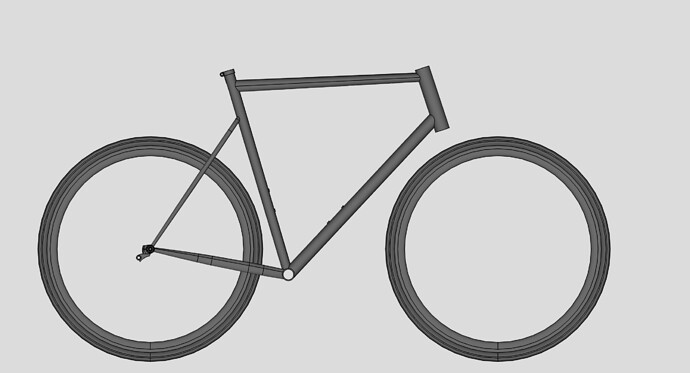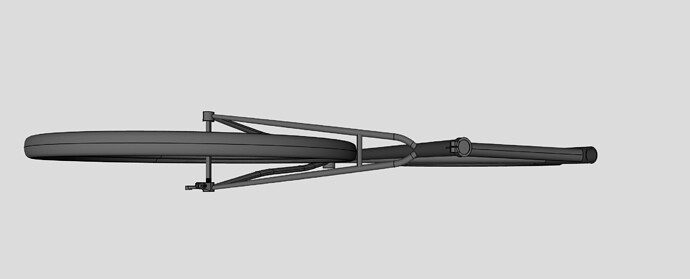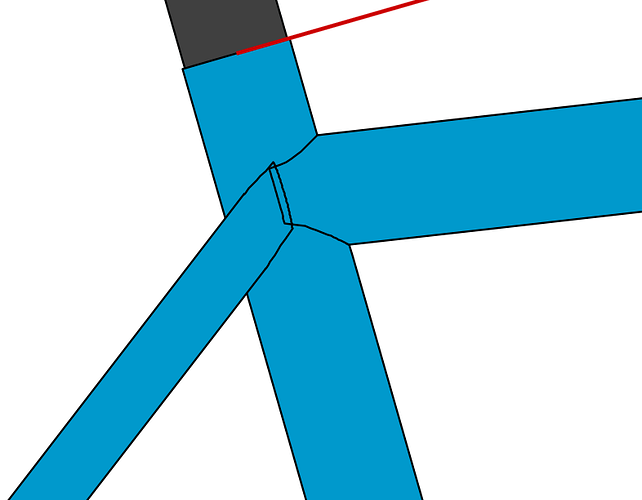Hello everyone,
in this topic I would like to know what the opinions on seatstaybridge and chainstaybridge are. I am planning a clean look for my latest project and would like to do without the seatstaybridge. I’ve done this several times and haven’t had any static problems so far. What speaks for and against such bridges? With a road bike there is also a small but fine weight loss.
Since the frame is quite large, I have some concerns about the stiffness.
I’m also a little undecided about the lowered seatstays. Do you think that the rear triangle will vibrate too much?
Thank you for your help
The dropped stays will eventually crack the seat tube if the seat tube is too thin, or if you place them on a butt.
You can see this thread as reference: How to fix crack?
Bridges aren’t structurally necessary, and it isn’t quite clear if they increase stiffness. Maybe @Daniel_Y has some FEA testing to show whether or not they have an effect on frame stiffness.
3 Likes
Is use the external buttet seating from zona. The wall thickness of the butt is 1,0mm so I think it works?
It’s a bit thin, IMO. Make sure the stays are on the 1.0mm portion, not the thinner butted version or it will break eventually.
I always shoot for 1.2mm for where my top tube / seat stays join, if the tube you’re using doesn’t have that wall thickness, I’d consider making a couple bilaminate pieces to thicken those sections up.
Here is an example of an externally butted seat tube with a 1.2mm wall thickness at the seatstay / top tube junction: Dedaccai Low Geo ST
The long externally butted section would most likely be long enough to get what you’re trying to achieve.
5 Likes
Agreed with @terraformbicycles, there seem to be a lot of cracked seat tubes. I think the conventional wisdom of ST wall thickness might be off. Not sure what people are using for seat tubes, but this 1.2x.6x.9 ST from Tange is really nice: 29.8/28.6MM Ø TANGE PRESTIGE SEAT TUBE EXT BUTTED 1.2/.6/.9 X 600MM 27.2 SEAT POST 20360 — BICYCLE FABRICATION SUPPLY
I think it’s impossible to say definitively that the bridge is not necessary.
However, I pose another question: has anyone seen a bike fail because of the lack of a SS bridge? I am not sure I have.
Also, great CAD! Is there a reason why your SS bends are so high? It will make it difficult to clamp/miter right on those bends. I usually start the bend right at the tire knob.
3 Likes
the “how to fix crack” post is mine, and it cracked only after about half a year of use. I would suggest making a sleeve to reinforce the tube at the place where you attach the top tube and the chainstays.
2 Likes
The cad drawing is made with bike cad so no compliments please.
love the look of the seat stays. It should become a little bit my signature thing😁 in my selfmade jig I can hold them tight and easy. do you think there is a problem because of the stretch of the bend?
@terraformbicycles Maybe I put a sleeve there ore do it in the classic way!
1 Like
nope, my concerns were just fixturing and mitering, but looks like you have that covered!
1 Like
FWIW, my 2019 Santa Cruz Chameleon doesn’t have a SS or CS bridge, and I’ve smashed that bike into a LOT of stuff pretty hard and it’s still going strong.

Photo from Santa Cruz website. Notice that the SS are welded to the sides of the ST and TT, allowing for an enormous amount of area on which to weld, making for a very strong joint. Kinda like Daniel/NMW’s very well designed Y-yoke that gets welded all the way around.
That said, I use SS bridges on all of my bikes because whether or not it is necessary I think it is ultimately a sturdier design due to reduced stress concentration (if designed properly). I also don’t mind the way they look.
3 Likes
I had the same question a few years ago and have since had discussions with a few builders who I trust and greatly admire who have said unequivocally that seat stay bridges and chain stay bridges are structurally unnecessary. The caveat is that when a wheel is installed in the frame the structure is rigid, but when the wheel is removed (for shipping, transport in a car, etc) that is when the rear triangle is a bit more vulnerable to being bent if it doesn’t have bridges. The only other reasons for bridges are aesthetics and fender mounts. Under even very aggressive riding, the bridges offer no strength or stiffness advantage. I build almost all my bikes without bridges.
5 Likes
Do you have some experience with the connection of seatstays and toptube? I built one with a life seattube and want to braze the seqtstays on the side of seattube. Do I need a sleeve because the wall thicknes is only 0.65mm? Or what’s the reason why people sometimes put a sleeve on the top of the seattube?
If you’re not using an externally butted seat tube or a lug then you’ll need to add a sleeve. The tube is otherwise too thin to support the top tube and seat stays, and it will eventually crack.
1 Like
@manzanitacycles
in my understanding it is A internal butted tube from Columbus or isn’t it? Its0.7 at bb than 0.45 and on the top section 0.65.
or what’s the reason why they produce the butt on the top?
It’s butted to .65 at top to fit a 27.2 seat post after reaming. But the tube is designed for using lugs. If you aren’t using a lug you’ll need to use a sleeve.
2 Likes
understood. Good that i’m asked. Thanks a lot!!
also if i place there a big silver fillet?
So there is a lot of material?
If you don’t reinforce the seat tube it will eventually fail. Reinforcement is either done with a lug or a sleeve. Or better yet, buy an externally butted seat tube and save yourself some work.
4 Likes
A couple years ago, I was finishing up a frame and hadn’t added the bridges. I forget what tubing or type of frame it was now. I doubt it matters. There was a current thread at the time on one of the forums, asking about bridges and how much stiffness they added etc.
I decided to do some ghetto testing. I put the BB on my alignment table and hung roughly 50-70lbs from the rear (dummy axle inserted). I measured a tiny amount of deflection (like 0.020"). I then installed bridges using silver (low temp) and measured again. I actually measured slightly more deflection AFTER installing the bridges. I can’t explain why this might be. I have hypotheses. I will say the difference was tiny (0.005" or something).
I concluded that they didn’t add stiffness or strength but were good for installing fenders.
2 Likes
For a more accurate test, you should apply the load in a variety of directions, eg upwards, downwards, left/right laterally, and also torsionally (mount a long bar through the dropouts and put the weight on the end). The rear of a bike probably deals with more load in torsion than any other mode.
Of course making use of the numbers such a test puts out is another matter altogether. At least you could say yes or no to whether bridges make a difference, but you might not know what that difference actually means.
I have built up two raw frames without bridges and then added them later on and noticed a difference in ride quality, especially brake feel with a seatstay/chainstay bridge and a seatstay mounted caliper. I generally use pretty thin (5/8) seat stays tho.
Mostly I wanted to +1 for not doing dropped seat stays. The only frame failures I have had are from my dropped seat stay era where I welded the stays to a thin section of seat tube not supported by a seat post. wrapping around the ST is a good idea too. Less likely to pierce the ST, more real estate. Those things flex a lot.
3 Likes




